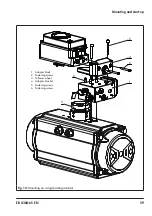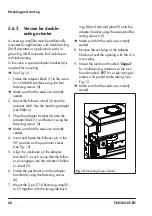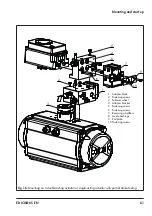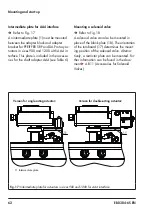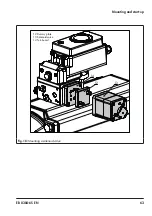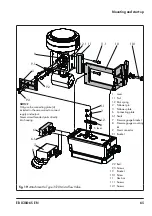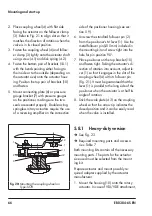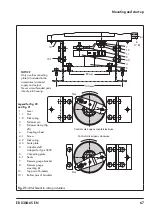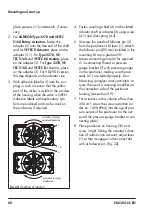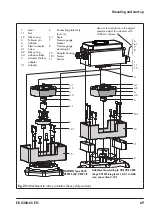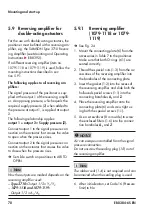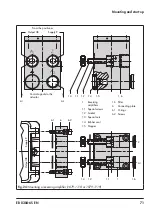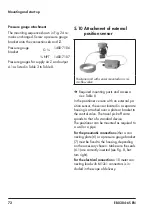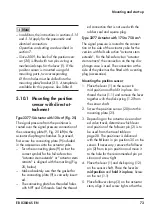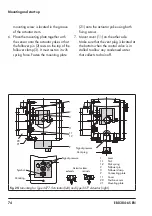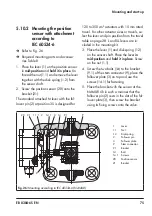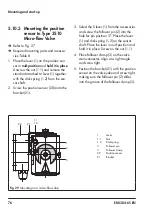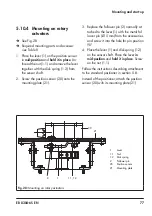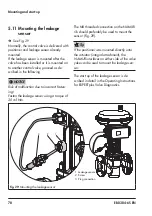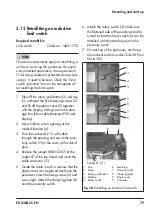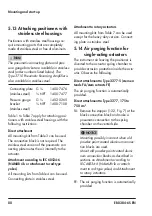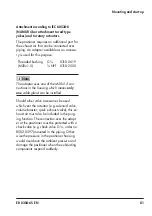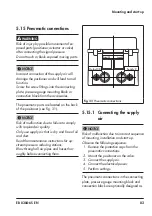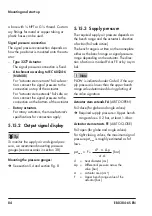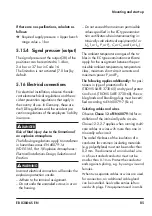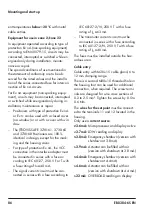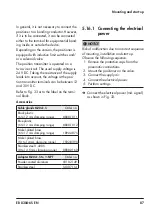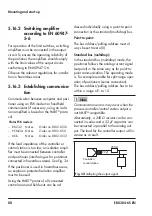
EB 8384-6S EN
73
Mounting and start-up
− In addition, the instructions in sections 5.15
and 5.16 apply for the pneumatic and
electrical connection.
Operation and setting are described in
section
.
− Since 2009, the back of the position sen-
sor (20) is fitted with two pins acting as
mechanical stops for the lever (1). If this
position sensor is mounted using old
mounting parts, two corresponding
Ø 8 mm holes must be drilled into the
mounting plate/bracket (21). A template is
available for this purpose. See Table 8.
5.10.1 Mounting the position
sensor with direct at-
tachment
Type 3277-5 Actuator with 120 cm² (Fig. 25)
The signal pressure from the positioner is
routed over the signal pressure connection of
the connecting plate (9, Fig. 25 left) to the
actuator diaphragm chamber. To proceed,
first screw the connecting plate (9) included
in the accessories onto the actuator yoke.
−
Turn the connecting plate (9) so that the
correct symbol for the fail-safe action
"actuator stem extends" or "actuator stem
retracts" is aligned with the marking (Fig.
25, below).
−
Make absolutely sure that the gasket for
the connecting plate (9) is correctly insert-
ed.
−
The connecting plate has threaded holes
with NPT and G threads. Seal the thread-
ed connection that is not used with the
rubber seal and square plug.
Type 3277 Actuator with 175 to 750 cm²:
The signal pressure is routed to the connec-
tion at the side of the actuator yoke for the
version with fail-safe action "actuator stem
extends". For the fail-safe action "actuator
stem retracts" the connection on the top dia-
phragm case is used. The connection at the
side of the yoke must be fitted with a venting
plug (accessories).
Mounting the position sensor
1. Place the lever (1) on the sensor in
mid-position and hold it in place. Un-
thread the nut (1.1) and remove the lever
together with the disk spring (1.2) from
the sensor shaft.
2. Screw the position sensor (20) onto the
mounting plate (21).
3. Depending on the actuator size and rat-
ed valve travel, determine which lever
and position of the follower pin (2) is to
be used from the travel table on
page 28. The positioner is delivered
with the
M
lever in pin position 35 on the
sensor. If necessary, remove the follower
pin (2) from its pin position and move it
to the hole for the recommended pin po-
sition and screw tight.
4. Place the lever (1) and disk spring (1.2)
on the sensor shaft. Place the lever
in
mid-position
and
hold it in place
. Screw
on the nut (1.1).
5. Place follower clamp (3) on the actuator
stem, align it and screw tight so that the
Note
Summary of Contents for TROVIS SAFE 3730-6
Page 12: ...12 EB 8384 6S EN...
Page 16: ...16 EB 8384 6S EN...
Page 22: ...22 EB 8384 6S EN...
Page 40: ...40 EB 8384 6S EN...
Page 42: ...42 EB 8384 6S EN...
Page 82: ...82 EB 8384 6S EN...
Page 90: ...90 EB 8384 6S EN...
Page 96: ...96 EB 8384 6S EN...
Page 132: ...132 EB 8384 6S EN...
Page 152: ...152 EB 8384 6S EN...
Page 155: ...EB 8384 6S EN 155...
Page 156: ...156 EB 8384 6S EN...
Page 157: ...EB 8384 6S EN 157...
Page 158: ...158 EB 8384 6S EN...
Page 159: ...EB 8384 6S EN 159...
Page 160: ...160 EB 8384 6S EN...
Page 161: ...EB 8384 6S EN 161...
Page 162: ...162 EB 8384 6S EN...
Page 163: ...EB 8384 6S EN 163...
Page 164: ...164 EB 8384 6S EN...
Page 165: ...EB 8384 6S EN 165...
Page 166: ...166 EB 8384 6S EN...
Page 167: ...EB 8384 6S EN 167...
Page 182: ...182 EB 8384 6S EN...
Page 183: ...EB 8384 6S EN 183...

